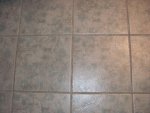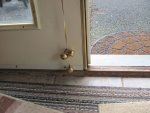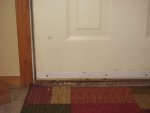Cynthia White
Member
- Messages
- 3,220
I live in a split-level house. One of the levels has a really ugly tile floor. Here it is. If it's not obvious it's light blue. I don't own anything blue. I don't like blue, and I'd like to do something with this floor.

The space it covers is an odd shape, but it's roughly 350 ft2 in total. It's a part of the house that doesn't have a basement so the tile is set on a concrete slab. And the tile is in good shape. No cracks or obvious wear. This is a high traffic area--dirty high traffic. There's a door going to the outside, and a door going to the garage, then steps upstairs and steps downstairs.
If I understand correctly, it's not easy to remove tile that's set directly onto the slab. I don't think changing the height of the floor will be a problem, because you already have to step down to go outside, go downstairs, and into the garage, and step up to go upstairs. I don't want vinyl because of the VOC's and I don't want carpet because of the dirt and high traffic.
So what's your opinion about the easiest, least expensive options? Can you tile over tile? Engineered wood? Real wood floor? Anything else?
Thanks for any and all replies.

The space it covers is an odd shape, but it's roughly 350 ft2 in total. It's a part of the house that doesn't have a basement so the tile is set on a concrete slab. And the tile is in good shape. No cracks or obvious wear. This is a high traffic area--dirty high traffic. There's a door going to the outside, and a door going to the garage, then steps upstairs and steps downstairs.
If I understand correctly, it's not easy to remove tile that's set directly onto the slab. I don't think changing the height of the floor will be a problem, because you already have to step down to go outside, go downstairs, and into the garage, and step up to go upstairs. I don't want vinyl because of the VOC's and I don't want carpet because of the dirt and high traffic.
So what's your opinion about the easiest, least expensive options? Can you tile over tile? Engineered wood? Real wood floor? Anything else?
Thanks for any and all replies.


 And Bob's yer uncle.
And Bob's yer uncle.



 so little by little, room by room, I'm going to change the pink and blue floor in the kitchen, pink bathroom etc. etc. etc.
so little by little, room by room, I'm going to change the pink and blue floor in the kitchen, pink bathroom etc. etc. etc.